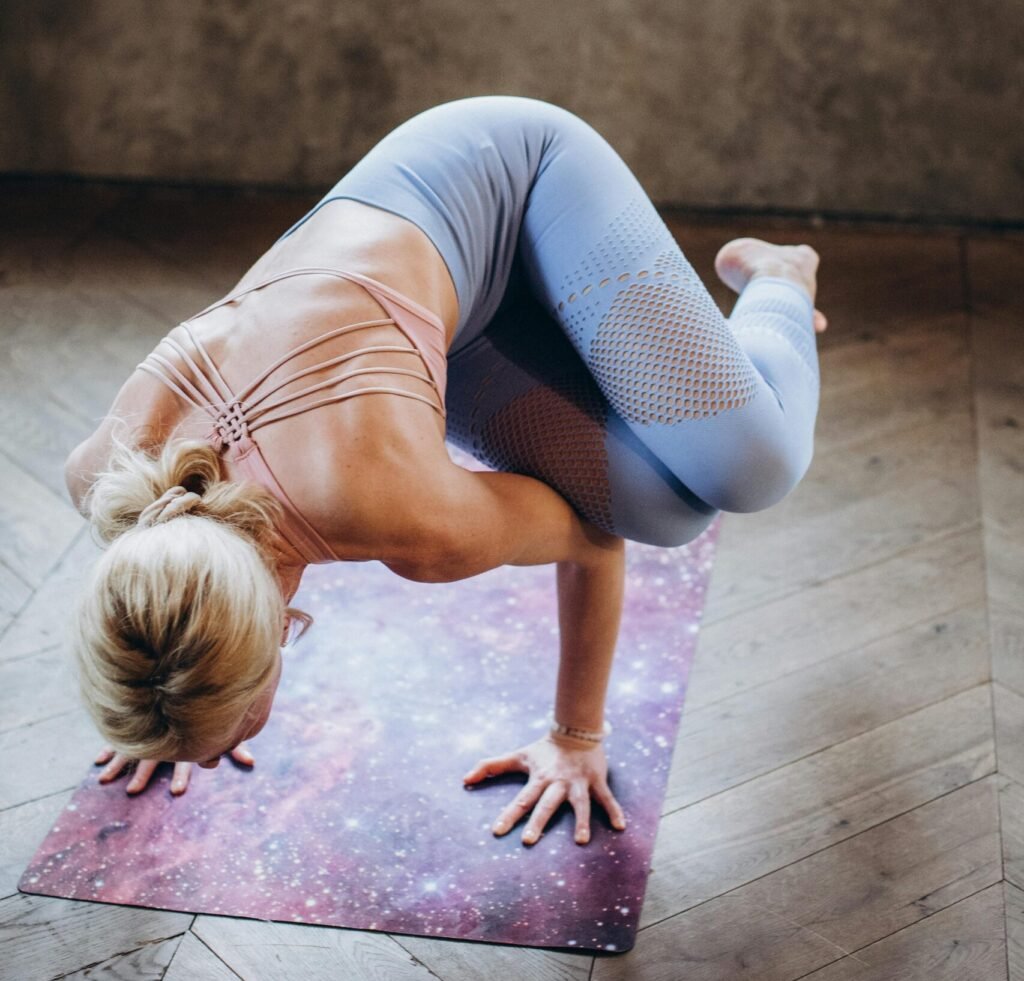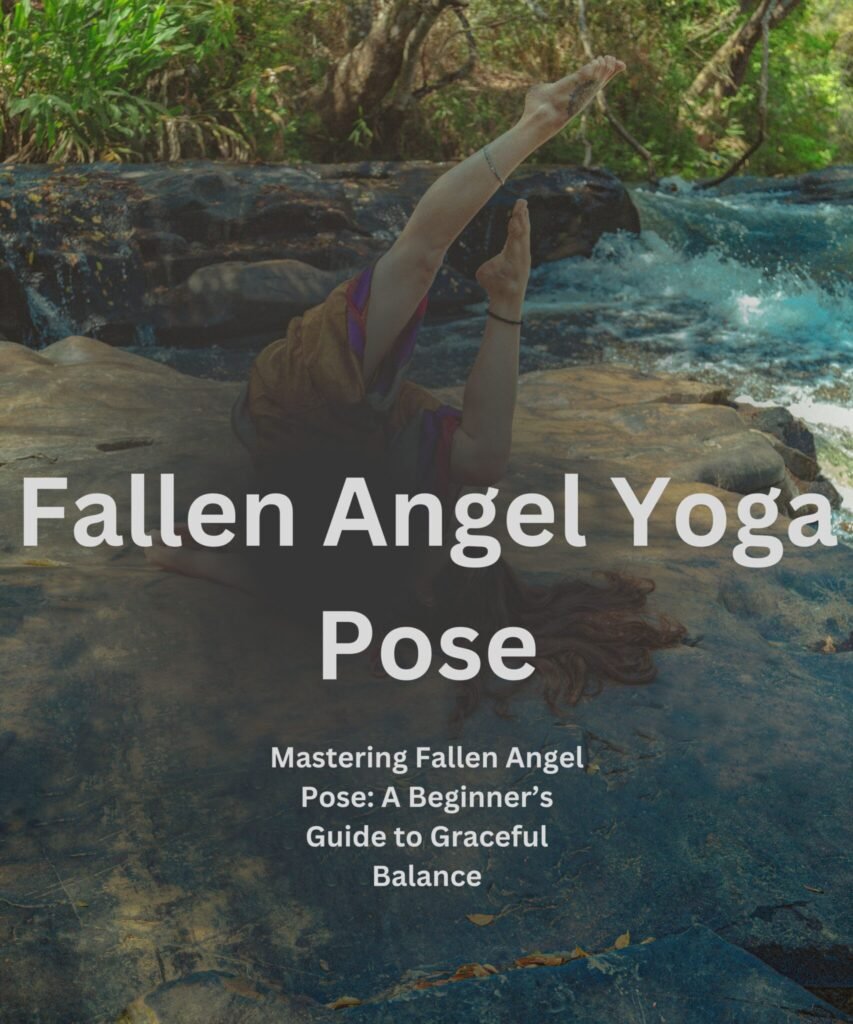Do you want to make your yoga practice a little more elegant and strong? Another name for this pose is Devaduuta Panna Asana. The Fallen Angel Yoga Pose could be just what you need. This pose is a favorite among yoga fans of all levels because it blends balance, flexibility, and poise.
This article will talk about the special benefits of the Fallen Angel Pose, show you how to do it step-by-step, and give you ideas on how to add it to your daily routine. The Fallen Angel Pose is a fun challenge that can change your practice, no matter how experienced you are with yoga or how new you are to it.
Let’s explore the fantastical world of the Fallen Angel Yoga Pose and find out how to get into this beautiful and powerful pose.
Table of Contents
The fascinating Fallen Angel Yoga Pose will help you find your inner power and grace. Take your practice to the next level and find the right balance between beauty and balance. Fallen Angel Yoga Pose

Benefits of the Fallen Angel Yoga Pose
By adding the Fallen Angel pose to your yoga routine, you can get a lot of mental and physical benefits. This pose is a great way to stretch, strengthen, and relax your body and mind, no matter how much experience you have with yoga. Let us look at the many great benefits it offers:
Strengthens Upper Body:
The arms, shoulders, and chest muscles that you use in Fallen Angel pose get stronger and more stable.
Betters Core Stability:
When you balance on one arm and one leg, your core muscles work hard to keep you steady. Over time, this makes your core stronger and your balance better.
Stretches Hamstrings and Hips:
In Fallen Angel pose, the extended leg stretches the hamstrings and hips deeply, making them more flexible and easing stress in these areas.
Improves Spinal Flexibility:
This pose makes your spine more flexible by arching your back and opening your chest. This can help relieve stiffness and improve your balance.
Boosts confidence and bravery:
To master the Fallen Angel pose, you need to be focused, determined, and ready to try new things. As you get better at yoga, you’ll feel proud of yourself and strong in ways that go beyond the mat and into other parts of your life.
Adding Fallen Angel pose to your normal yoga routine can help your body, mind, and spirit in many ways. You’ll feel stronger, more flexible, and more balanced both on and off the mat.
How to perform the fallen angel pose:
Warm-up: Begin with a few rounds of sun salutations or any other gentle warm-up sequence to prepare your body for the pose. Focus on loosening up your shoulders, hips, and hamstrings.
Set up: Start in a seated position on your mat with your legs extended in front of you. Bend your knees and plant your feet firmly on the ground, hip-width apart. Place your hands behind your hips, fingers pointing toward your feet.
Lift into Bridge Pose: Press into your palms and feet as you lift your hips toward the ceiling, coming into Bridge Pose. Keep your chin tucked slightly, and engage your core to protect your lower back.
Transition to Fallen Angel: From Bridge Pose, bend your elbows and lower your forearms to the mat, keeping them parallel to each other. Shift your weight onto your left forearm as you extend your right leg straight up toward the sky.
Find your balance. Engage your core muscles to stabilize your body as you lift your left leg off the mat, extending it parallel to the floor. Keep your gaze steady and find a focal point to help you maintain balance.
Extend and reach: Reach your right arm overhead, keeping it in line with your right ear. Allow your torso to rotate slightly to the left, opening up your chest and shoulders.
Hold and breathe: Hold the Fallen Angel pose for 3-5 deep breaths, maintaining steady engagement in your core and leg muscles. Focus on lengthening your limbs and lifting your heart toward the sky.
Release with control: To exit the pose, slowly lower your left leg back to the mat, followed by your right leg. Release your right arm and gently lower your hips back down to the mat, returning to Bridge Pose.
Rest and repeat: Take a moment to rest in corpse pose, allowing your body to integrate the benefits of the pose. If desired, repeat the sequence on the opposite side to balance out your practice.
Remember, yoga is a journey, not a destination. Approach each pose with patience, mindfulness, and respect for your body’s limitations. With consistent practice and dedication, you’ll soon soar into the Fallen Angel pose with ease and grace.

Tips for Mastery
Start Slow: Begin with a gentle warm-up to prepare your body for the pose. This could include some light stretching or a few rounds of Sun Salutations.
Build Core Strength: Fallen Angel requires a strong core for stability and balance. Incorporate exercises like planks and boat pose into your routine to strengthen your abdominal muscles.
Open Your Shoulders: Since Fallen Angel involves lifting one arm overhead, shoulder flexibility is key. Practice shoulder-opening stretches like shoulder rolls and cow face pose to increase mobility.
Focus on Breath: Pay attention to your breath throughout the pose. Deep, steady breathing can help you stay calm and centered, even when challenging your balance.
Use Props: Don’t hesitate to use props like blocks or straps to modify the pose as needed. They can provide support and help you maintain proper alignment.
Engage Your Legs: Keep your legs active and engaged to support your lower body during the pose. Press firmly through the grounded foot and lift through the extended leg to create a strong foundation.
Listen to Your Body: Honor your body’s limitations and avoid pushing yourself too hard. If something doesn’t feel right, back off and explore a gentler variation of the pose.
Practice Regularly: Like any yoga pose, mastering Fallen Angel takes practice and patience. Incorporate it into your regular yoga routine and watch your strength and flexibility improve over time.
By following these tips and practicing regularly, you’ll be well on your way to mastering the Fallen Angel yoga pose and experiencing its many benefits.

READ ABOUT “SIDE CROW POSE YOGA: STRENGTHEN YOUR BODY AND MIND” BY CLICKING
Conclusion
In the end, the Fallen Angel yoga pose is a lovely mix of grace, power, and balance. Adding this pose to your yoga routine will not only make your core and upper body stronger, but it will also make you feel strong and confident. Take on the task, enjoy the thrill of flight, and let your inner angel fly. The Fallen Angel pose challenges you to find new ways to express yourself and learn more about yourself, no matter how long you’ve been practicing yoga or if you’re just starting out. Spread your wings and let your practice fly with this beautiful pose.
FAQ
Most frequent questions and answers
The Fallen Angel pose is a captivating variation of the traditional yoga pose, the Side Plank or Vasisthasana. In this pose, the practitioner balances on one arm while extending the other arm and leg towards the sky, creating a graceful arc resembling a fallen angel.
This pose offers a myriad of benefits, including strengthening the arms, shoulders, core, and legs. It also improves balance, concentration, and coordination. Additionally, the Fallen Angel pose stretches the chest, shoulders, and hip flexors, promoting flexibility and relieving tension.
While Fallen Angel pose might appear advanced, beginners can still enjoy its benefits with modifications. Starting with the foundational Side Plank pose and gradually progressing towards Fallen Angel under the guidance of a certified yoga instructor can help beginners build strength and confidence.
As with any yoga pose, it’s crucial to listen to your body and honor its limitations. Avoid forcing or overextending yourself into the pose, and always maintain proper alignment to prevent injuries. Individuals with wrist, shoulder, or back injuries should consult with a healthcare professional before attempting Fallen Angel pose.








[…] You might be interested in “FALLEN ANGEL YOGA POSE: A BEGINNER’S GUIDE AND TIPS.” click to READ […]